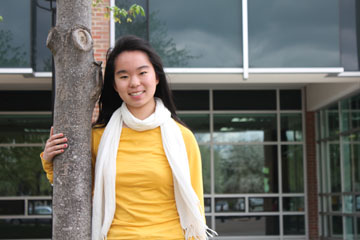Long blond hair. White skin. European features. It’s what most girls think of when they think of beauty. This is why it was a bit unexpected to many when People Magazine named Lupita Nyong’o the most beautiful woman of the year. She is not the first African American to claim this title, but Nyong’o has said it was painful for her as a young girl to grow up with very dark skin. She recently shared this childhood secret saying, “My one prayer to God was that I would wake up lighter skinned.” Even in 2014, with the prominence of non-white women like Michelle Obama and Beyoncé, color and beauty continue to be an issue. The backlash surrounding Nyong’o’s crowning shows that America still has a long way to go when it comes to viewing different skin colors as equally beautiful.
ABC News recently recreated a 1939 experiment in which a sociologist showed dolls of different skin and hair colors to 5-8 year-olds. The results mirrored those taken 75 years ago: nearly every single girl said the blond white doll was most beautiful. When asked which doll they would like to take home, the girls began a tug-of-war, all fighting to take home the blond doll.
 If I had partaken in that experiment, I probably would have engaged in that tug-of-war too. As women from all parts of the world, we are convinced that lighter skin and hair is better. I played with a number of dolls as a little girl, and they were all the same: very white, very blond and very European. I always chose the blond doll over the brunette one and never even saw dolls that weren’t white. I used to wish my hair wasn’t so black and would lighten into more of a dark brown and that my eyes were a lighter color. It was a struggle for me growing up, and part of that struggle was I didn’t see any role models telling me otherwise that having darker skin and hair was equally beautiful.
If I had partaken in that experiment, I probably would have engaged in that tug-of-war too. As women from all parts of the world, we are convinced that lighter skin and hair is better. I played with a number of dolls as a little girl, and they were all the same: very white, very blond and very European. I always chose the blond doll over the brunette one and never even saw dolls that weren’t white. I used to wish my hair wasn’t so black and would lighten into more of a dark brown and that my eyes were a lighter color. It was a struggle for me growing up, and part of that struggle was I didn’t see any role models telling me otherwise that having darker skin and hair was equally beautiful.
The mindset that having lighter features is better has negatively influenced women around the world. Seventy-seven percent of women in Nigeria reportedly use skin-lightening cream on a regular basis, and in other African countries, it’s as high as 59 percent, according to the World Health Organization. And it’s not just African women; it’s women in China, India, Middle East — all to look more European. “Fair and Lovely,” a skin-whitening treatment, is one of the most successful businesses in India. In Asia, there are a multitude of products — creams, special foods, laser treatments — all promising lighter skin.
TV and media may be partly to blame. Seventy percent of the faces we see are white and just 16 percent are black. For all the years People Magazine has come out with the list of “Most Beautiful,” very few times have African American women graced the cover. The standard of beauty has been so twisted from Hollywood and media. It is because we so rarely see different ethnicities of women presented as beautiful on television that we have developed this mindset that there is only one standard for beauty. We need more Lupita Nyong’os recognized for being beautiful in order to change the way we look about color and beauty. Perhaps in many years, kids will start choosing the darker colored doll as most beautiful.
The views in this column do not necessarily reflect the views of the HiLite staff. Reach Helena Ma at hma@hilite.org.

































![AI in films like "The Brutalist" is convenient, but shouldn’t take priority [opinion]](https://hilite.org/wp-content/uploads/2025/02/catherine-cover-1200x471.jpg)









































![Review: “The Immortal Soul Salvage Yard:” A criminally underrated poetry collection [MUSE]](https://hilite.org/wp-content/uploads/2025/03/71cju6TvqmL._AC_UF10001000_QL80_.jpg)
![Review: "Dog Man" is Unapologetically Chaotic [MUSE]](https://hilite.org/wp-content/uploads/2025/03/dogman-1200x700.jpg)
![Review: "Ne Zha 2": The WeChat family reunion I didn’t know I needed [MUSE]](https://hilite.org/wp-content/uploads/2025/03/unnamed-4.png)
![Review in Print: Maripaz Villar brings a delightfully unique style to the world of WEBTOON [MUSE]](https://hilite.org/wp-content/uploads/2023/12/maripazcover-1200x960.jpg)
![Review: “The Sword of Kaigen” is a masterpiece [MUSE]](https://hilite.org/wp-content/uploads/2023/11/Screenshot-2023-11-26-201051.png)
![Review: Gateron Oil Kings, great linear switches, okay price [MUSE]](https://hilite.org/wp-content/uploads/2023/11/Screenshot-2023-11-26-200553.png)
![Review: “A Haunting in Venice” is a significant improvement from other Agatha Christie adaptations [MUSE]](https://hilite.org/wp-content/uploads/2023/11/e7ee2938a6d422669771bce6d8088521.jpg)
![Review: A Thanksgiving story from elementary school, still just as interesting [MUSE]](https://hilite.org/wp-content/uploads/2023/11/Screenshot-2023-11-26-195514-987x1200.png)
![Review: "When I Fly Towards You", cute, uplifting youth drama [MUSE]](https://hilite.org/wp-content/uploads/2023/09/When-I-Fly-Towards-You-Chinese-drama.png)
![Postcards from Muse: Hawaii Travel Diary [MUSE]](https://hilite.org/wp-content/uploads/2023/09/My-project-1-1200x1200.jpg)
![Review: "Ladybug & Cat Noir: The Movie," departure from original show [MUSE]](https://hilite.org/wp-content/uploads/2023/09/Ladybug__Cat_Noir_-_The_Movie_poster.jpg)
![Review in Print: "Hidden Love" is the cute, uplifting drama everyone needs [MUSE]](https://hilite.org/wp-content/uploads/2023/09/hiddenlovecover-e1693597208225-1030x1200.png)
![Review in Print: "Heartstopper" is the heartwarming queer romance we all need [MUSE]](https://hilite.org/wp-content/uploads/2023/08/museheartstoppercover-1200x654.png)




